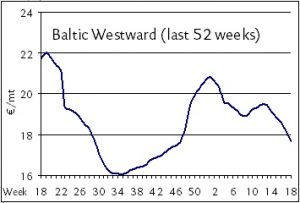On 3 February 1637, at a Dutch auction, not enough buyers of tulip bulbs were found and the tulip bubble burst. Many speculators and investors lost all of their belongings.
Since the 16th century, tulip bulbs from Armenia and Turkey have been imported to Europe. First, the tulips were sold at reasonable prices. After new varieties were bred, a true tulip mania began. The demand was huge, but it took a long time to grow the tulips. Thus, a low supply was offset by a great demand.
People, rich and poor, entered the business with the popular plant. Most of them had no interest in gardening, but only in the trade of the flower. Knowledge of horticulture was not necessary anyway, since one could turn to intermediaries who only demanded start-up capital.
Holland at that time was a world power, attracting much gold and silver that was shipped into the country. Thus, existing goods faced more money (inflation) and prices rose. This presented the basic conditions for the emergence of a tulip bubble.
Around 1623, the rare tulip variety Semper Augustus came to the Netherlands. One of them cost 1,000 guilders, which was about six years’ income for a worker. Other varieties were later even traded for up to 10,000 guilders. At the time, this was the equivalent of a house in Amsterdam. However, the plants were not traded on the Amsterdam stock exchange, but rather in so-called taverns, where auctions were carried out.
But one day, on February 3, 1637, there were not enough buyers at one of the auctions: the tulip bubble burst. In the following months, prices for the former prestige object collapsed by 99%. Speculators went broke in droves.
Representatives of Dutch cities came together at the end of February to set up commissions. They laid down the rule that open futures contracts could be paid off by a penalty of 3.5% of the purchase price. This was paid by the growers and thereby the commissions wanted to prevent a spread of the distortions to other sectors of the economy.
This tulip bubble is considered the first well-documented speculative bubble in economic history
To get exclusive and intelligent shipbroking analysis like this each and every morning, simply subscribe to the BMTI Daily Report.

 Declines in freights seem to have started to accelerate as the days of May lengthen with the lingering impact of holiday-strewn weeks having the expected braking effect on business activity in general. Charterers have given up trying to play nice for the time being as owners note a more aggressive attempt to push freights to new lows. Cargo demand, despite being promised to return in earnest after Q1, remains less than spectacular, to put it nicely. Even for a European coaster market that has seen very little tonnage expansion in recent years, and one that remains thankfully tightly-bound to cargo demand, the wide availability of tonnage is undeniable. High teens that were tracked for most of the year on the westward Baltic route—from Balticum to ARAG—in the range of EUR 18-20/mt are now moving toward EUR 16-17/mt and lower, brokers report. Longer runs from the German Baltic to WCUK are looking at mid-low EUR 20s/mt of about EUR 23-25/mt, depending on terms. This remains true, although traders are already assuming the same business will be going for EUR 22-23/mt by the end of the month. The reverse trip from WCUK to the lower Baltic is seeing 3,000mt general cargoes fix middle teens of EUR 14-15/mt.
Declines in freights seem to have started to accelerate as the days of May lengthen with the lingering impact of holiday-strewn weeks having the expected braking effect on business activity in general. Charterers have given up trying to play nice for the time being as owners note a more aggressive attempt to push freights to new lows. Cargo demand, despite being promised to return in earnest after Q1, remains less than spectacular, to put it nicely. Even for a European coaster market that has seen very little tonnage expansion in recent years, and one that remains thankfully tightly-bound to cargo demand, the wide availability of tonnage is undeniable. High teens that were tracked for most of the year on the westward Baltic route—from Balticum to ARAG—in the range of EUR 18-20/mt are now moving toward EUR 16-17/mt and lower, brokers report. Longer runs from the German Baltic to WCUK are looking at mid-low EUR 20s/mt of about EUR 23-25/mt, depending on terms. This remains true, although traders are already assuming the same business will be going for EUR 22-23/mt by the end of the month. The reverse trip from WCUK to the lower Baltic is seeing 3,000mt general cargoes fix middle teens of EUR 14-15/mt.